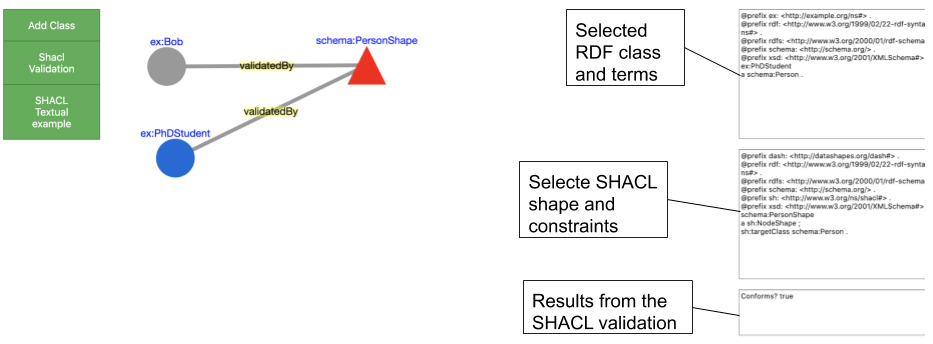An integrated environment for Visualizing, Validate, and Versioning RDF graph
This prototype was developed using:
- Linux
- Docker
- HTML and javaScript
We have two ways, a simple in which you just need to execute a command line, but it will kill all your docker instances to guarantee the instance of QUIT store or you go step by step and saving your dockers instances and giving the rights that you think it's better for you at your own risk.
Execute this comand in your bash.
- This commmand will automatically (1) Clone the repository, (2) Giving administrative permissions to the shaclEditor directory, (3) Prune all existing docker instances, (3) Initialize the QUIT store:
bash <(curl -s https://raw.githubusercontent.com/firmao/shaclEditor/master/InstallShaclEditor.sh)
after all, inside shaclEditor directory, open the index.html in your web-browser.
Clone the repository:
git clone https://github.com/firmao/shaclEditor.git
Giving permissions, we suggest the followiing permissions, but please, change as far you feel confortable.
sudo chown 1000 shaclEditor
sudo chmod u+w shaclEditor
cd shaclEditor
Create a docker instance for our versioned triple store (QUIT store)
docker run -it --name containername -p 8080:8080 -v quitrepo:/data aksw/quitstore
Now the QUIT store are supposed to be running at http://localhost:8080/ and we need to insert a first triple as a place holder to garantie that the triple store is working properly:
curl -d "insert data { graph <http://example.org/> { <urn:shacleditor> <http://shacleditor#id> 0 } }" -H "Content-Type: application/sparql-update" http://localhost:8080/sparql
after all, inside shaclEditor directory, open the index.html in your web-browser.
A video with a minimal example here, just a proof of concept of a very first stage of this project (now should be different).
An unfinished version of the manual is here
- 1 - Create Concepts/classes and properties
- 2 - Create Shacl shapes and relate to the concepts
- 3 - Create instances of the concepts/classes and check if the instances are valid with Shacl constraints
- Create RDF classes and add properties and RDF terms.
- Create SHACL shapes and add constraints to validate the content in your RDF classes.
- Execute and see the results of your SHACL validation on your RDF classes and terms.
- Execute SPARQL queries over the graphs with QUIT store.
- Obtain versions of the RDF Knowledge Base, due to the use of the QUIT store.
- RDF classes are represented by circles and SHACL shapes are represented by triangles.
- The SHACL validation and the RDF representation are in the textAreas on the right side of the screen.
As a motivation of our work, we describe two distinct scenarios where the proposed resource may be useful:
Given an RDF class called person, assuming that a person cannot die before his birthday and this person can only have one social security number.
The following questions are raised:
- How to validate if the birthDate and Death date are correct?
- How to validate if a person has only one social security number?
- How to do all this validation without know RDF or SHACL constraints?
In this case, an approach is needed to enable the user to create graphically RDF classes validating the data with SHACL shapes. The best solution for this case was to create a Graphical User Interface (GUI) on the web, which allows the user to create RDF classes and terms and validating the data using SHACL constraints in a pervasive way.
Given an RDF class with terms, the user, without knowledge in RDF or SHACL wants to validate the information.
The following will be needed:
- A GUI to load the RDF class.
- A GUI to add constraints to this RDF class.
Given a visual representation of a class their constraints.
- How to generate an RDF representation of the class and the constraints?
- From the RDF, how to generate a visual representation of the RDF class and the SHACL constraints?
- A GUI for non-RDF/SHACL users(see usability study).
- Create and Edit SHACL constraints and RDF classes and terms, totally online.
- The most simple technology, basically it's only HTML and javascript applied. Many IDE's could be used to load the project, such as IntelliJIDEA, VisualSutdioJS, etc... just clone and start coding, no dependencies, no frameworks, no complex databases etc...
More details on the paper.
contact: firmao@gmail.com
